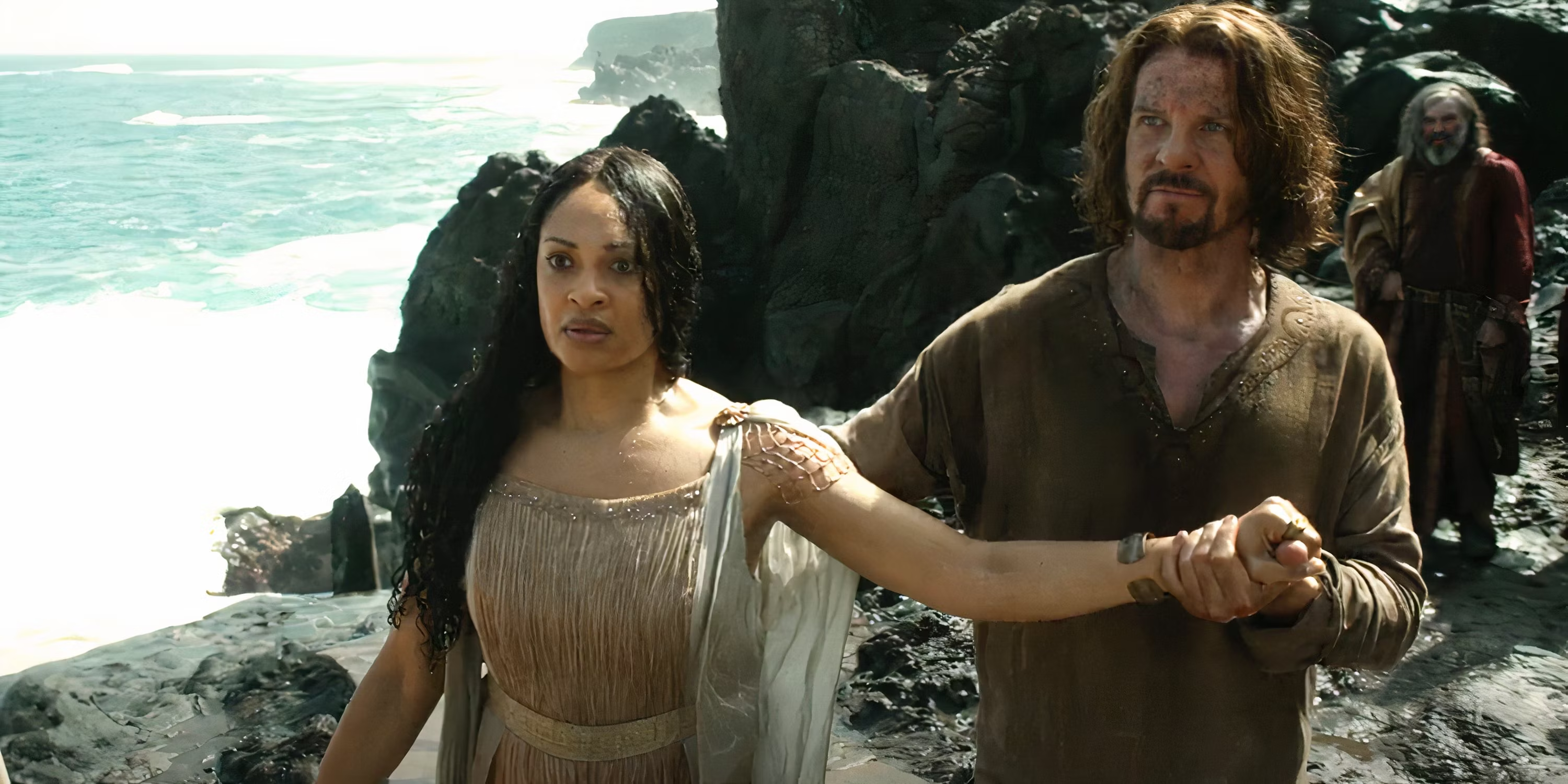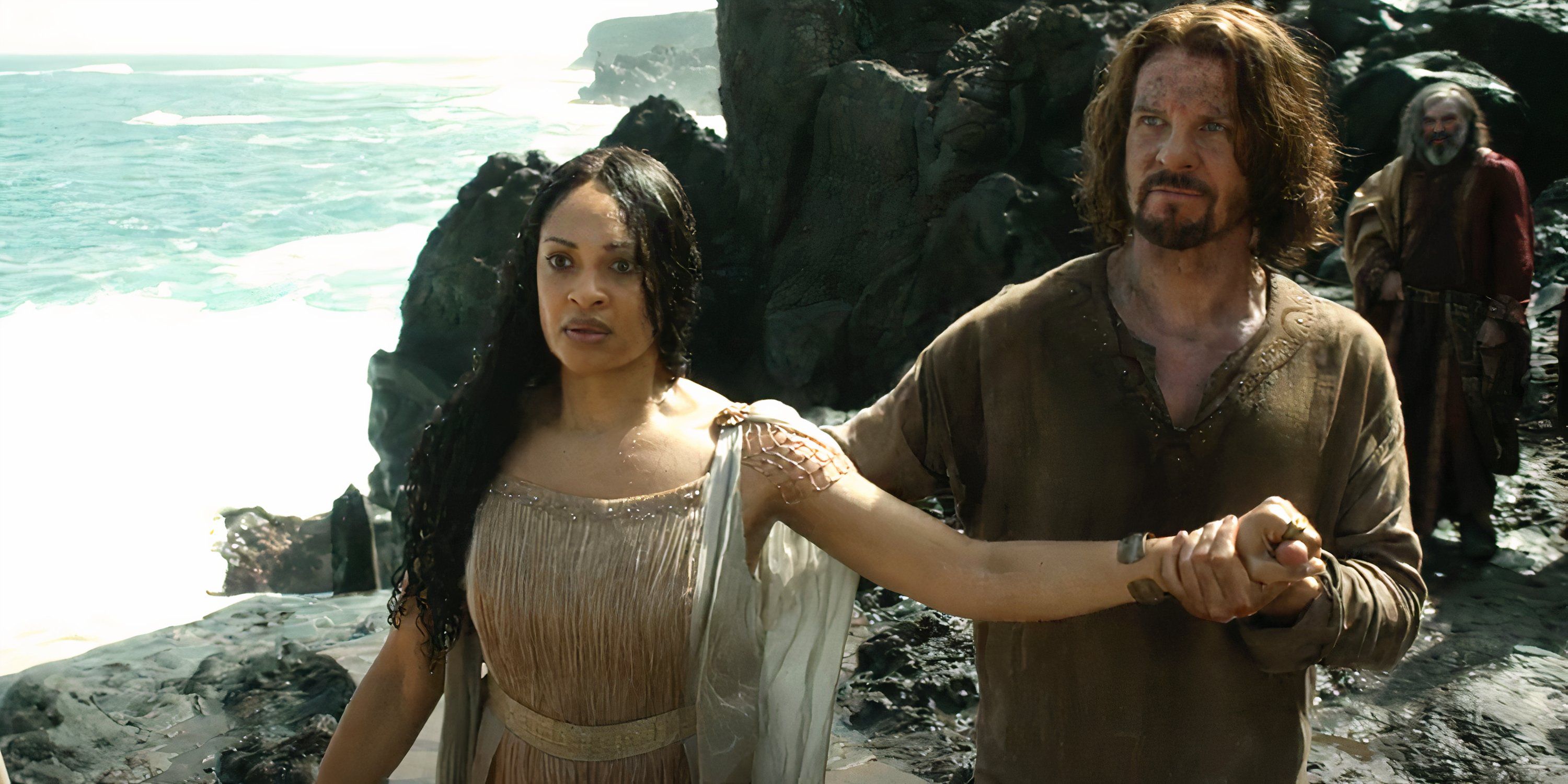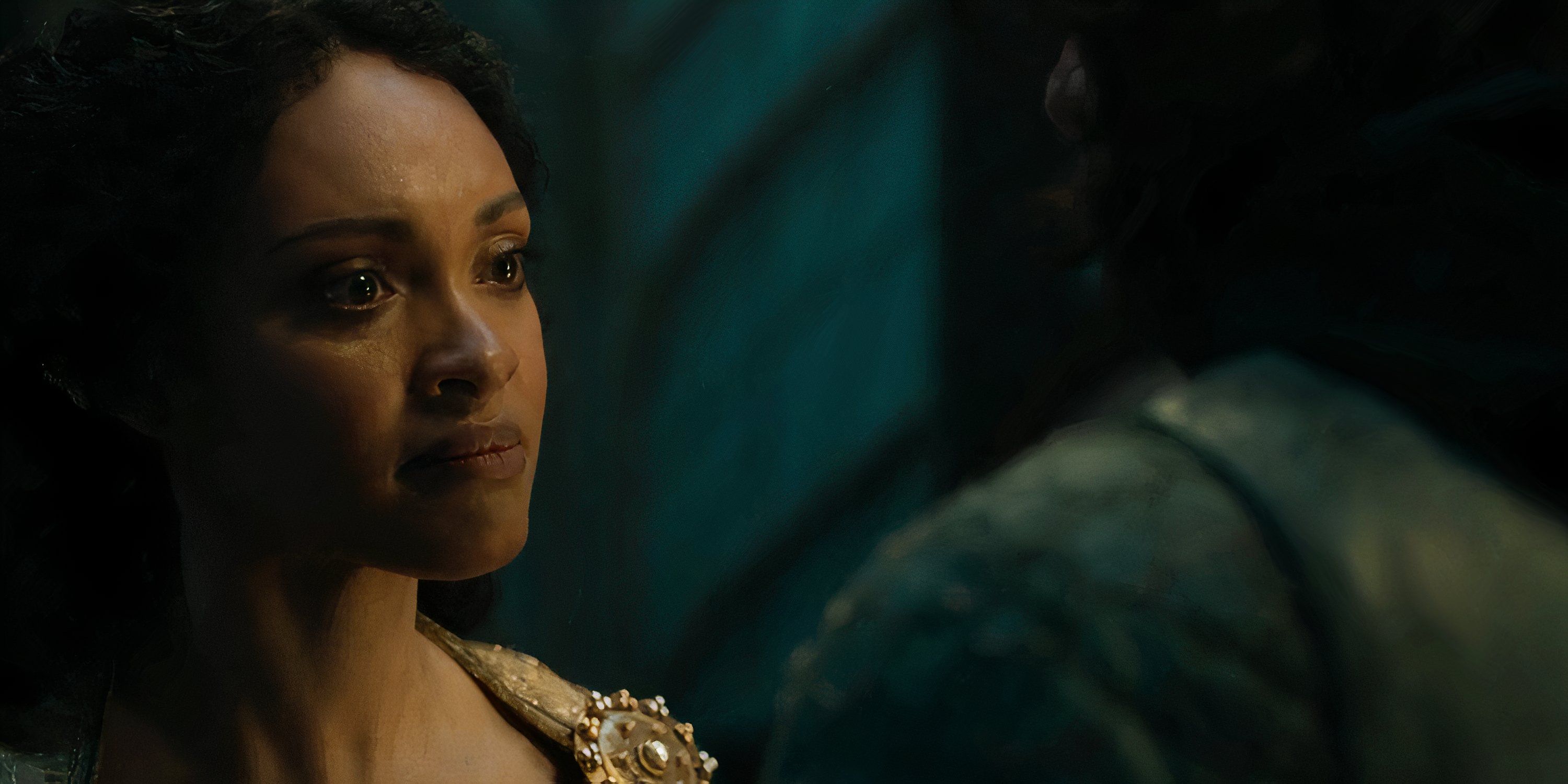
In the most recent episode of Amazon The Lord of the Rings: The Rings of Power, “Where is he?” Elendil is sentenced to stand trial by Pharazôn as punishment for high treason against Númenor. Lord Belzagar recommends an elven test to determine Elendil’s loyalty. He pulls out a book displaying an image of what appears to be an ancient sea serpent devouring a man whole, declaring, “If the faithful wish to live by the old ways, they must also die by them.” It is unclear what this means, but it does not bode well for the once-proud sea captain. Míriel and her daughter, Eärien, attempt to dissuade him from maintaining his loyalty to the usurped queen in order to save his life – but he refuses, saying that “faith is not faith unless it is lived.”
Although it is still unclear what Lord Belzagar means when he says that they “will let the Valar decide [Elendil’s] “Destiny” makes it clear that he will soon come face to face with a monster of the deep. In a moment of unexpected heroism, Míriel takes his place to confront the beast. Shortly after being pulled beneath the surface, she resurfaces on shore, having been brought back from the sea by the serpent. But it’s unclear what all this means in the larger scheme of Middle-earth, except perhaps to those familiar with the great mythos of author JRR Tolkien’s world.
Tolkien had many unnamed beasts and entities in his canon
Tolkien had many named and unnamed creatures in his vast and sprawling world of Arda, of which Middle-earth is but one continent. In the later episodes of Rings of Power, The public has already seen entities like the Barrow-wights. These creatures appeared in the novel The Lord of the Rings: The Fellowship of the Ring in the Barrow Hills, near the Old Forest, just outside the Shire. Merry, Pippin, and Frodo encounter them and are briefly captured by the spirits that inhabit the tombs. They have connections to the Witch-king of Angmar, leader of the Nazgûl. They appear as ghosts and have a hypnotic ability to taunt and lure unsuspecting travelers to their deaths.
The audience also sees hints of the appearances of a most infamous creature in this season of Rings of Power. Gandalf memorably faced Morgoth’s Balrog in The Fellowship of the Ring and “smote his ruin upon the mountainside.” Also known as Valaraukar or Durin’s Bane, Balrogs were originally Maiar – spirits that shaped the world and the Valar in the beginning. At some point, they were turned to darkness after being seduced by Morgoth (the first Dark Lord) in the Elder Days. The Balrog, which most fans know from the films, made its way into the recesses of Moria, where the Dwarves awakened it, and the Fellowship encountered it much later. It seems that Rings of Power will represent this legendary fall of the kingdom of the dwarves, whose citizens awaken the Balrog after digging “too greedily and too deeply.”
Outside of Moria was another mysterious entity encountered by the Fellowship in the first installment of The Lord of the Rings In the chapter “A Journey in the Dark”, the Watcher in the Water, or simply the Watcher, appears as a beaked, tentacled creature in Peter Jackson’s adaptations. It attempts to capture Frodo outside the gates of Moria, driving the Fellowship into its dark, cavernous recesses. Visually, Jackson relied on a surprisingly succinct description from Tolkien. On the page, the creature is rather simply described upon its encounter with Frodo: “A long, sinuous tentacle had crawled out of the water; it was pale green, luminous, and wet. Its finger-like tip held Frodo’s foot and dragged him through the water.” The exact size and girth of the Watcher beneath the water’s surface remains unknown.
Creatures forced to serve others include Wargs and Oliphaunts. Wargs are a race of wolves ridden by Orcs. They appear in Rings of Power as well as The Lord of the Rings and are usually depicted as stocky, humped, dog-like creatures. Oliphaunt is the name given by Hobbits to the elephant-like creature, Mûmakil. Indeed, they are so much a part of Hobbit lore that Samwise Gamgee is expressly excited when he first sees one. They were used in battle by the Haradrim, a segment of Men from a region south of Gondor known as Haradwaith. Jackson depicts these Men and beasts in The Two Towers and in the Battle of Pelennor Fields in The Return of the King.
Míriel’s trial at sea was invented for the Rings of Power but is in the tradition of Tolkien.
Míriel’s interception at Elendil’s trial is not canon in Tolkien’s lore (nor Eärien for that matter), but it is a great dramatic moment in the series. When Lord Belzagar refers to the Valar, he is referring to the beings who created order in the world of Arda and shaped it. They inhabit the continent of Aman. Ulmo was the Vala responsible for governing the oceans of Arda. He could be compared to Poseidon in Greek mythology. Ulmo had a vassal, a sea spirit named Ossë, who was mostly associated with the tidal coasts and less with the deep seas. It is therefore likely that the unnamed sea worm is acting on behalf of either Ulmo or Ossë (or both) when it brings Míriel back from the sea.
|
Míriel Character Analysis |
|
Names) : Tar-Míriel, Míriel |
|
Securities: Queen Regent of Númenor |
|
Relations: Tar-Palantir (father), Pharazôn (cousin), Elendil (love interest — in Rings of Power) |
|
Spouse: Ar-Pharazôn |
|
Actor: Cynthia Addai-Robinson |
|
Death: Second Age 3319, Fall of Númenor |
Tolkien has no exact equivalent to the sea serpent that appears in Rings of Power in his fictional works related to The Lord of the Rings. This does not mean that it could not and that the authors take extreme liberties. Indeed, The Lost Road and Other Writings — other Middle-earth stories that were published after the author’s death – he mentioned them. The series of drafts and essays includes them as a sort of footnote in a discussion of Elvish legends and linguistics. Rings of Power The writers took the kernel of an idea and expanded it to fit a particular moment for a certain character. Besides, what could be more nautical than a mythical sea worm for an island kingdom of sailors?
In some of his other works, Tolkien included sea creatures similar to that of Rings of PowerIn 1927 he wrote a children’s book called Random Rover The story is about an adventurous dog named Rover. The book includes fantasy elements such as wizards, the Man in the Moon, and voyages on the high seas. Tolkien wrote the story to comfort his son, who lost his favorite dog on the beach during a family vacation. One sequence in the book features Rover and mermaids battling a sea serpent that has been awakened from an indefinite sleep beneath the waves and must be brought back to rest. The book was not published in the United Kingdom and the United States until 1998, with an audiobook released in 2005.
The romantic connection between Elendil and Míriel was created for Rings of Power
Created among others for Rings of PowerThe canon of the series is Elendil’s pseudo-romantic relationship with Míriel. So far, it’s mostly lingering glances and eye contact, but their interactions are clearly coded. No romantic relationships have been established in the series yet, aside from Bronwyn and Arondir and Disa and Prince Durin in Season 1. But with Bronwyn’s death at the start of Season 2, it seems like the writers are turning to the characters of Isildur and Elendil to fill in a missing element of the series. This is probably a better decision given that the elf-human relationship has already been addressed in The Lord of the Rings with Arwen and Aragorn. The relationship between Bronwyn and Arondir didn’t raise any new questions, while a queen and her loyal captain (although as Lord of Andúnië, Elendil isn’t exactly a commoner himself) could be an intriguing interaction to explore.
Míriel’s fate is inevitably linked to the fall of Númenor in Tolkien’s texts. She dies when she is enveloped by a great wave, as she saw in her vision in the Seeing Stone.
In Tolkien’s writings, Míriel marries Pharazôn, her cousin. But it remains to be seen whether the series will follow this path or not. Tolkien had two different versions of how this might play out in his drafts, one where Míriel was in love with Pharazôn and the other where he forced the marriage. Perhaps the relationship with Elendiel is meant to supplant this disturbing plotline entirely. It could be that fans won’t complain about that. Also There is much to be said for changing traditions. After all, this book is intended for a modern audience and some liberties are inevitable.
Even with the changes underway, Rings of Power has delivered a gripping Season 2 so far. It has clearly picked up the pace from Season 1, which as a first season lends itself to a glacial pace as introductions and world-building take place. With just two episodes left in the season, viewers are left wondering what will be resolved and what will be left open for Númenor and its citizens after such a turbulent ride in Season 2.

